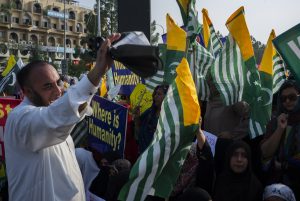U.K. High Commissioner to Pakistan Jane Marriott’s visit to Mirpur on January 10 prompted a formal protest from India. New Delhi had similarly relayed its concerns to Washington following U.S. Ambassador Donald Blome’s trip to Gilgit-Baltistan (GB) in October. Mirpur is the second-largest city of the region Pakistan describes as Azad Jammu and Kashmir (AJK), which along with GB forms the Pakistan-administered sections of Kashmir, the subject of the 77-year dispute between the two nuclear armed South Asian neighbors.
India claims both AJK and GB as part of its territory, in addition to its own administered Kashmir, which New Delhi bifurcated into two union territories – Jammu and Kashmir, along with Ladakh – revoking their special status in 2019. The territories governed by India are, likewise, claimed by Pakistan.
Pakistan commemorates every February 5 as Kashmir Solidarity Day across the country, in addition to GB and AJK. Ubiquitous rallies customarily echo slogans deeming united Kashmir as Pakistan’s “jugular vein,” with much of the national discourse aimed at condemning India’s rule. Meanwhile, addressing the plight of the Kashmiris under Pakistan’s control isn’t a part of any such vows or deliberation.
Multifaceted protests have exploded in Gilgit-Baltistan, which Islamabad has longed carved into a geopolitical loophole for its strategic interests. However, it is the part of Kashmir that Pakistan describes as “azad,” meaning free, where a volatile rupture with Islamabad is most palpable. A civil disobedience movement led by the Joint Awami Action Committee (JAAC) has been underway in AJK over the past eight months, protesting inflated electricity and wheat prices. A significant percentage of the AJK population hasn’t paid their electricity bills since the summer of last year, with observers asserting that the majority of local households are partaking in the boycott.
The JAAC maintains that given AJK’s contribution to Pakistan’s power generation, the locals should be the first beneficiaries of the region’s hydroelectric projects.
“AJK contributes up to 3,500 MW worth of electricity to Pakistan. Our peak consumption is around 400 MW. We should be given electricity at the production cost,” Shaukat Nawaz Mir, the president of the local traders’ body, and a member of the JAAC, told The Diplomat. A lowered electricity cost is one of the 10 points that the committee has penned in its charter of demands.
As per a Senate committee review in 2021, AJK provides 2,700 MW to Pakistan’s power grid, with the region’s hydroelectric potential deemed to be triple that amount. Led by the Mangla Dam and the Neelum-Jhelum plant, AJK is responsible for over a third of Pakistan’s around 8,000 MW hydropower generation.
However, with AJK supplied electricity by Pakistan’s Water and Power Development Authority (WAPDA), the locals in the region are asked to pay tariffs as per the National Electric Power Regulatory Authority’s (NEPRA) formula. This has seen AJK residents being charged an electricity rate of over 30 Pakistani rupees per unit, despite hours of load-shedding, whereas the power production cost is lower than 2 rupees per unit.

































